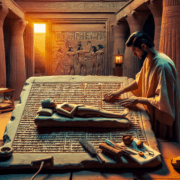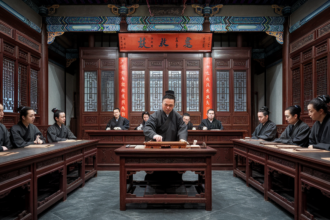The use of fingerprintsFingerprint, impression made by the papillary ridges on the ends of the fingers and thumbs. Fingerprints afford an infallible means of personal identification, because the ridge arrangement on every finger of every human being is Read Full Definition by prehistoric humans provides a captivating journey through human history. From prehistoric cave art to early civilizations like Mesopotamia, Egypt, and China, fingerprints have played a crucial role in personal identification and artistic expression. The discovery of ancient fingerprints on artifacts and art offers insights into social structures. It also reveals cultural practices and technological advancements of early societies.
This article explores evidence

Prehistoric Fingerprint Discoveries
Prehistoric fingerprints offer valuable clues about early human life, shedding light on the social dynamics, craftsmanship, and cultural practices of ancient communities. These unique impressions, left behind on art, pottery, and tools, connect us directly to the hands of our ancestors.
Cave Art Evidence
Some of the earliest evidence of fingerprint use comes from prehistoric cave art. In southern Spain, a natural rock shelter known as Los Machos contains red ocher paintings dating back approximately 7,000 years. These drawings feature human figures, geometric motifs, and scenes from daily life. Through fingerprint analysis, researchers identified two potential artists: a man who was at least 36 years old and a juvenile girl aged between 10 and 16. This suggests that cave painting may have been a communal activity involving different generations and genders.
In paleolithic caves in France and Spain, hand stencils dating back over 25,000 years also bear missing digits, leading to the theory that early humans engaged in ritualistic finger amputation. Some researchers suggest that men and women may have had their fingers deliberately chopped off as part of religious rituals, based on the analysis of over 200 hand stencils showing missing digits.
This discovery challenges the idea that cave painting was a solitary or male-dominated activity. The presence of both adult and juvenile fingerprints indicates a shared social activity, possibly involving different generations. Other research suggests that women created around 75 percent of the rock art in French and Spanish caves, further supporting the idea that artistic endeavors were communal.
Neolithic Figurines
Neolithic figurines also provide important evidence of prehistoric fingerprints. In the Neolithic settlement of Tell Halula in Syria, figurines dating back 8,000 years were discovered with visible fingerprints on their surfaces. The analysis of these prints suggests that adult males likely crafted these artifacts. However, due to the limited sample size, broader conclusions about the social structure of the artisans are speculative.
These findings demonstrate that early humans, particularly during the Neolithic period, used their fingerprints in both artistic and functional contexts. The fingerprints on Neolithic figurines not only provide evidence of early craftsmanship but also offer insights into the demographics and social roles of the artisans.
Ancient Pottery Markings
Pottery is another valuable source of prehistoric fingerprints. In Turkey, at the Ulucak Mound, fingerprints on pottery dating back 8,000 years demonstrate the communal nature of ceramic production, involving both adults and children as young as 11. This pottery workshop is one of the oldest known in the world, and the fingerprints provide a glimpse into early craftsmanship.
In Scotland’s Orkney archipelago, fingerprints found on late Neolithic Grooved Ware pottery dating to 3000 B.C. shed light on the ceramic techniques of ancient communities. These prints offer rare insights into the production techniques and the individuals involved in crafting these vessels.
Stone Tool Impressions
Its worthy to note stone tools could also potentially hold fingerprint impressions. Modern techniques, such as Reflectance Transformation Imaging (RTI) and 3D fingerprint recognition, can help analyze these ancient tools, providing further insights into prehistoric tool-making practices.
The study of prehistoric fingerprints continues to evolve, with new technologies like RTI and 3D fingerprint recognition allowing researchers to extract detailed information from ancient impressions. These methods enable scientists to determine the age, sex, and demographic details of the individuals who left these prints, giving us deeper insights into prehistoric societies.
Fingerprints in Early Civilizations
As human societies became more organized, fingerprints took on significant roles in commerce, law, and personal identification. In Mesopotamia, Egypt, and China, they served practical purposes long before the development of modern forensic science.
Mesopotamian Uses
The ancient Mesopotamian civilization recognized the importance of fingerprints in legal and commercial contexts. Sumerian clay tablets from as early as 1750 BC bear fingerprints used in business transactions, serving as a form of identification and authenticationVerifying the identity of a user, process, or device, often as a prerequisite to allowing access to resources in an information system. Read Full Definition. This practice highlights Mesopotamia’s sophisticated record-keeping and legal systems.
Sumerian scribal schools (edubas) have revealed clay tablets with student fingerprints. These prints were left by students learning to write cuneiform on clay tablets during the Old Babylonian period (ca. 2000–1600 BCE). In Nippur, a cuneiform school text shows not only fingerprints but teeth marks, suggesting that a young student bit into the tablet during a lesson.
Interestingly, even experienced scribes left their fingerprints on documents, showing that smudging was a common challenge when working with clay tablets. The human element in the writing process is further illustrated by the discovery of school texts containing teeth marks from young students.
Egyptian Applications
In Egypt, fingerprints were found on ushabtis, small funerary figurines crafted by female adolescents, indicating that women played an important role in their creation. These figurines were placed in tombs to serve the deceased in the afterlife.
Additionally, Egypt had a sophisticated system of seals and impressions for record-keeping, identification, and legal functions. Fingerprints likely played a role in administrative and legal practices, along with other forms of seals. These seals served as early authentication tools in Egyptian governance and could have included fingerprints for personal identification purposes.
Chinese Implementations
China has a long history of recognizing the uniqueness of fingerprints. Evidence suggests that the Chinese were aware of the individuality of fingerprints over 5,000 years ago. The earliest documented use of fingerprints for identification purposes in China dates back to the Qin Dynasty (221 to 206 B.C.). A document from this period, The Volume of Crime Scene Investigation—Burglary, describes the use of handprints as evidence in legal cases.
After the invention of paper in A.D. 105, it became common practice to sign documents using friction ridge skin. During the Tang Dynasty (618–907 A.D.), fingerprints were used to authenticate documents, including divorce matters. The historian Kia Kung-Yen, writing in A.D. 650, compared notches on legal wooden tablets to fingerprints, emphasizing their role in identification.
The use of fingerprints and handprints for authenticating documents required skilled individuals who could accurately read and verify the impressions. This early form of fingerprint verification in China shows a deep understanding of the uniqueness of fingerprints, predating modern forensic techniques by centuries.
Evolution of Fingerprint Knowledge
The scientific study of fingerprints began in the 17th century, marking the transition from using fingerprints for practical purposes in ancient civilizations to their role in modern forensic science.
Anatomical Understanding
Dr. Nehemiah Grew was the first to study friction ridge skin scientifically. His work, published in 1684, described the structure of fingerprints in detail. Marcello Malpighi, an Italian physiologist, later built on this work, using a microscope to explore the purpose and function of friction ridge skin.
Malpighi’s findings showed that the ridges on fingers increase friction, helping humans grasp objects and walk. This laid the groundwork for understanding the practical purpose of fingerprints in human physiology.
Recognition of Uniqueness
The notion that no two fingerprints are identical was first proposed in 1788 by J.C.A. Mayer, a German anatomist, who noted the uniqueness of friction ridge skin patterns. Sir Francis Galton later expanded on this theory in his 1892 book Finger Prints. Galton established that fingerprints remain unchanged throughout a person’s life, confirming their reliability as a tool for personal identification.
Galton’s work laid the foundation for the Henry Classification System, which became the standard method of fingerprint identification used in law enforcement worldwide.
Modern Methodologies for Analyzing Ancient Fingerprints
Modern technological advancements have revolutionized the study of ancient fingerprints. These methods allow researchers to extract detailed information from ancient prints, offering insights into demographics, cultural practices, and social roles.
Geometric Morphometrics and Ridge Density Analysis
Geometric morphometrics and Bayesian mixture modeling are used to analyze ridge density in ancient fingerprints. Ridge density varies by age and sex, allowing researchers to make demographic estimates based on ancient prints. This method enhances our understanding of the individuals who left these prints behind.
3D Fingerprint Recognition
3D fingerprint recognition offers unprecedented detail, enabling researchers to study the exact patterns and depth of ancient fingerprints. By reconstructing prints in three dimensions, researchers can extract valuable information about the individuals who left these impressions, offering a more comprehensive understanding of early human societies.
Conclusion: Fingerprints as a Link Between Past and Present
The study of prehistoric and ancient fingerprints provides a unique link between past and present. From prehistoric cave art to early civilizations like Mesopotamia, Egypt, and China, fingerprints have been used for identification, authentication, and artistic expression. These prints offer a tangible connection to our ancestors, revealing their social structures, cultural practices, and technological advancements.
As forensic science continues to evolve, the study of fingerprints remains a crucial tool in understanding human history. Modern analysis techniques allow us to uncover new insights into how early humans interacted with the world around them, providing a deeper understanding of their daily lives and social dynamics. To learn more about the history and timeline of forensic science, including the fascinating world of ancient fingerprints, visit SimplyForensic.com.
FAQ
What is the significance of prehistoric fingerprints?
Prehistoric fingerprints provide valuable insights into early human life, revealing social dynamics, craftsmanship, and cultural practices of ancient communities. They are often found on artifacts like art, pottery, and tools, serving as a direct link to our ancestors.
What evidence of fingerprint use comes from prehistoric cave art?
The earliest evidence of fingerprint use comes from prehistoric cave art found in southern Spain and paleolithic caves in France and Spain. These fingerprints, left by different generations and genders, suggest that cave painting was a communal activity.
What role did fingerprints play in early civilizations like Mesopotamia, Egypt, and China?
In early civilizations, fingerprints were used in commerce, law, and personal identification. For instance, in Mesopotamia, fingerprints were used in business transactions and legal contexts. In Egypt, they were found on funerary figurines and seals used for record-keeping and legal functions. In China, fingerprints were used for identification and document authentication.
How has the study of ancient fingerprints evolved with modern technology?
Modern technology like Geometric Morphometrics, Ridge Density Analysis, and 3D fingerprint recognition has revolutionized the study of ancient fingerprints. These techniques allow researchers to extract detailed information about the individuals who left these prints, offering a deeper understanding of early human societies.











